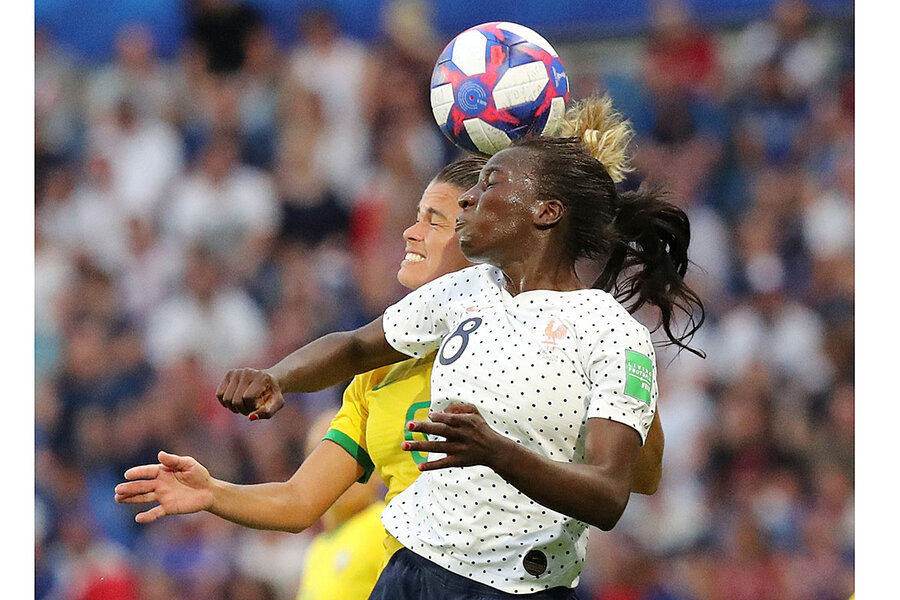No longer sidelined, women’s soccer attracts players and fans in France
Loading...
| Paris
When Nolwenn Legouic first played soccer 20 years ago as a young teenager, she had to brave her parents’ disapproval, play in boys’ cleats and uniforms, and put up with derisive taunts from her male neighbors.
But that was another era. Since then, she says “it’s night and day, things have changed so much” in France. The parents of girls she now coaches are delighted to see them play soccer, she says, and “soccer is becoming a game for everyone.” Sales of women’s soccer gear at the sporting goods chain store where Ms. Legouic works have risen this year by 90%, she says.
Women’s soccer is exploding in France, with the number of players nearly tripling over the past eight years, commercial sponsors investing big money in the sport, and a French team dominating the European club scene.
Why We Wrote This
Getting people to embrace women’s soccer, even at the highest tier of performance, has been a struggle in Europe. But this year’s Women’s World Cup seems to be a breakthrough moment, especially for host France.
The Women’s World Cup (WWC), currently underway in cities across France, has generated exceptional enthusiasm and drawn record numbers to stadiums and TV sets. “This tournament looks like it is going to be a breakthrough event,” says Matthieu Barberousse, the man in charge of World Cup coverage for the French sports daily L’Equipe. “We haven’t seen anything like it.”
This all reminds Brigitte Henriques – a former French international player and now vice president of the French Football Federation (FFF) – of the United States. “When I used to play in America it was like a dream, how much recognition the game had, how the players were stars,” she recalls. “Now that dream is coming true in France.”
And elsewhere in Europe: Women’s club games have attracted record crowds this year in Italy and Spain. And in the U.K. Barclay’s Bank, which sponsors the men’s Premier League, recently announced it will also sponsor the Women’s Super League to the tune of a reported $13 million over the next three seasons.
But nowhere else in Europe has the women’s game grown so fast over the past few years as in France, where the number of players has shot up from 54,000 in 2011 to 140,000 today, according to the FFF.
A lot of that, say observers, is down to Noel Le Graët.
In 2011, recently elected as FFF president after the national men’s team had disgraced itself at the World Cup, Mr. Le Graët went to Germany for the Women’s World Cup. He was no fan of women’s soccer, but he found enthusiastic crowds in full stadiums watching entertaining games. What’s more, France made it as far as the semifinals, the national team’s best performance.
With Ms. Henriques newly elected as the FFF’s first female secretary-general, the federation set about revamping women’s soccer in France from bottom to top, encouraging schoolgirls to take up the sport and establishing a network of elite training centers for adult female players modeled on the federation’s existing system for men. The FFF doubled its budget for women’s soccer to $16 million a year.
A key part of Mr. Le Graët’s vision was to host the 2019 Women’s World Cup, with all its attendant media attention and patriotic hoo-ha. “Winning the World Cup bid was the best thing that could have happened to us,” says Ms. Henriques.
At L’Equipe, editors had a hunch that this World Cup could be different, pushing women’s soccer into the big time. “It is evident that we are living through a moment in society when people are looking at women’s issues with new eyes,” says Mr. Barberousse. “That leads to a new balance.”
L’Equipe assigned 17 reporters to the WWC, only one less than it sent to Moscow last year for the men’s tournament. In 2015, when the last WWC was played in Canada, the magazine sent only two journalists.
The response from readers, who are overwhelmingly male, has surprised Mr. Barberousse. “Three weeks ago they had nothing good to say about women’s soccer,” he says. “Whenever we wrote anything about it hardly anyone read the stories and all the comments were negative.
“Now we are getting a lot of positive feedback,” he goes on. “A lot of men have changed their attitude. They don’t talk about players on the French team as women; they talk about them as players.”
Ms. Legouic says she has been surprised by the number of men and boys attending the WWC matches. And she is delighted. “When boys see women play football at this level,” she says, “that means a 50-year jump forward in attitude change.”
TF1, the most-watched French TV channel, has been surprised too. Almost as many people watched France play Brazil last Sunday as had watched the French men’s national team play an equivalent game in Moscow last year. (France’s next match will be Friday, when it faces off against the U.S. in what some are calling “the final that should have been.” France is one of seven European teams to make the quarterfinals, the first time that has ever happened.) The channel has upped its advertising rates for the French team’s matches twice and decided to screen both semifinals, even if France is not playing; it had previously relegated the games to a subsidiary channel.
“A cultural barrier has fallen and things are moving,” says Ms. Henriques. “Soccer is a game for both men and women now.”







